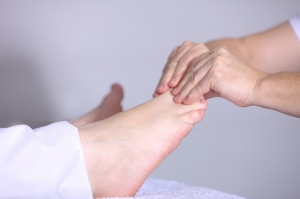Massage, guided imagery relieve anxiety and insomnia, study says
February 6, 2017
 Clinical massage and guided imagery may be a low-cost alternative to conventional medical treatment for patients with pain, anxiety, and insomnia, according to a study published in the journal, Critical Care Nurses. Researchers from Beaumont Health System in Royal Oak, Michigan found that patients' self-reported pain and anxiety scores improved immediately after a clinical massage. Patients who listened to a guided imagery recording found that intervention improved pain, anxiety, and insomnia symptoms. The Michigan health system uses integrative medicine to supplement traditional care, and has 33 massage therapists onsite. The research team, which conducted the study at the facility's progressive care unit, divided a group of 288 patients. One group was offered a 15-minute clinical massage everyday for five days. A massage therapist used Swedish massage techniques with the patient in their hospital bed, incorporating hand, foot, scalp, and neck massage, depending on the patient's comfort level. The second group of patients listened to a 30-minute audio recording designed to reduce pain and anxiety, and promote sleep. The study found that patients who indicated pain prior to a massage decreased from a mean of 4.5 to a mean of 2.3 afterward. More than 80 percent indicated a decrease in pain of at least one point after the intervention. Patients who indicated some level of anxiety decreased from a mean of 4.0 before the massage to a mean of 1.9 afterward. More than 80 percent indicated a decrease in anxiety of at least one point after their massage. In addition, 80 percent of the 45 patients who used the guided-imagery sessions stated that the intervention helped in some way. Overall, both groups reported an improvement in symptoms, and researchers say the findings show promise in the use of guided imagery as a more affordable intervention with the potential to reach many patients. However, the study noted that the patient population in the progressive care unit may have affected participation, since many patients may have been too ill to participate. Progressive care nurses in a hospital typically manage patients who are more stable than those in critical care but who require increased nursing care or more rigorous monitoring than those receiving care in a medical-surgical unit. The American Association of Critical-Care Nurses (AACN) introduced the term "progressive care" more than a decade ago to describe the care needs of acutely ill patients who are moderately stable with a high risk of instability. Click here to read more about the study.
Clinical massage and guided imagery may be a low-cost alternative to conventional medical treatment for patients with pain, anxiety, and insomnia, according to a study published in the journal, Critical Care Nurses. Researchers from Beaumont Health System in Royal Oak, Michigan found that patients' self-reported pain and anxiety scores improved immediately after a clinical massage. Patients who listened to a guided imagery recording found that intervention improved pain, anxiety, and insomnia symptoms. The Michigan health system uses integrative medicine to supplement traditional care, and has 33 massage therapists onsite. The research team, which conducted the study at the facility's progressive care unit, divided a group of 288 patients. One group was offered a 15-minute clinical massage everyday for five days. A massage therapist used Swedish massage techniques with the patient in their hospital bed, incorporating hand, foot, scalp, and neck massage, depending on the patient's comfort level. The second group of patients listened to a 30-minute audio recording designed to reduce pain and anxiety, and promote sleep. The study found that patients who indicated pain prior to a massage decreased from a mean of 4.5 to a mean of 2.3 afterward. More than 80 percent indicated a decrease in pain of at least one point after the intervention. Patients who indicated some level of anxiety decreased from a mean of 4.0 before the massage to a mean of 1.9 afterward. More than 80 percent indicated a decrease in anxiety of at least one point after their massage. In addition, 80 percent of the 45 patients who used the guided-imagery sessions stated that the intervention helped in some way. Overall, both groups reported an improvement in symptoms, and researchers say the findings show promise in the use of guided imagery as a more affordable intervention with the potential to reach many patients. However, the study noted that the patient population in the progressive care unit may have affected participation, since many patients may have been too ill to participate. Progressive care nurses in a hospital typically manage patients who are more stable than those in critical care but who require increased nursing care or more rigorous monitoring than those receiving care in a medical-surgical unit. The American Association of Critical-Care Nurses (AACN) introduced the term "progressive care" more than a decade ago to describe the care needs of acutely ill patients who are moderately stable with a high risk of instability. Click here to read more about the study.



















SHARE